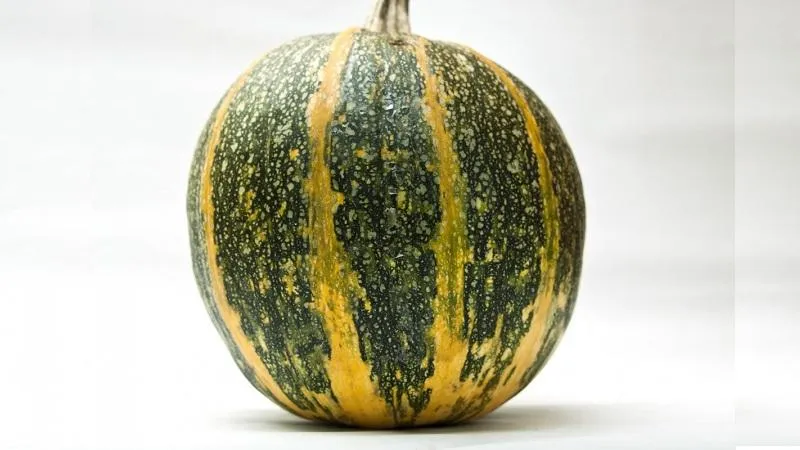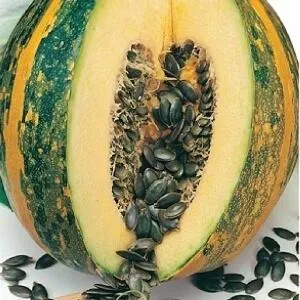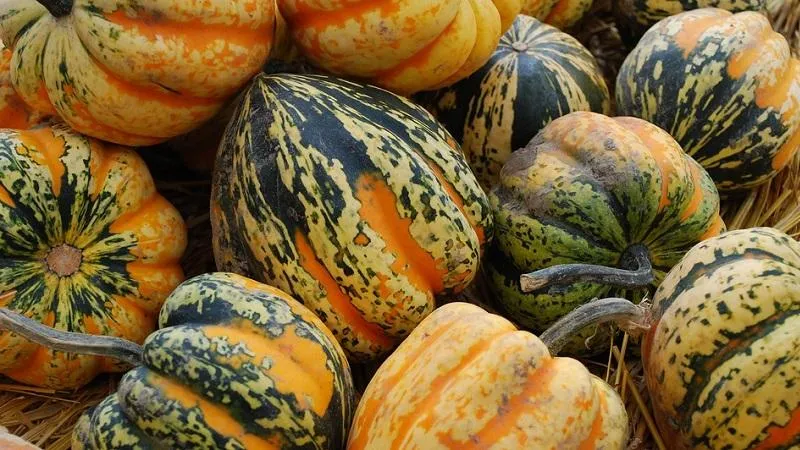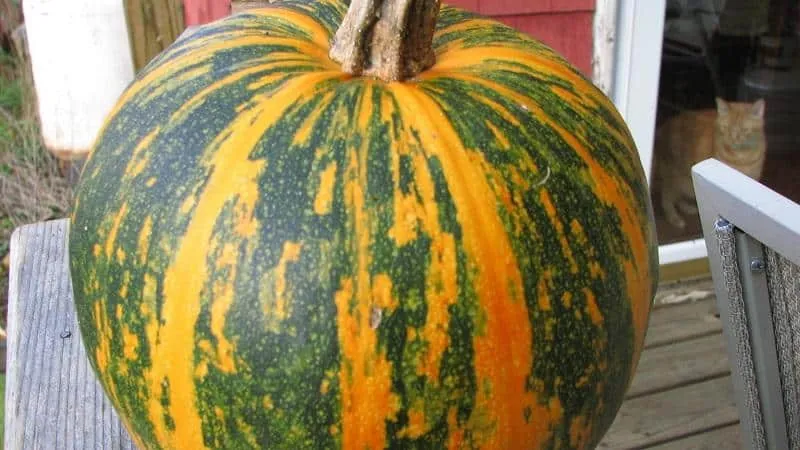Many have heard about the benefits of pumpkin seed oil. Regular consumption of this product helps remove cholesterol from the body and improves overall well-being. Pumpkin seed oil is much healthier than sunflower or even olive oil. It is made from pumpkin seeds.
During production, hulless seed varieties are particularly sought after, as they contain the highest number of seeds. These pumpkins can be grown in an ordinary garden. Below, we’ll explore how to plant and cultivate them correctly.
Table of contents
Brief Descriptions of the Most Popular Varieties
Hulless pumpkin varieties have been cultivated in Europe since the early 20th century. Pumpkin seeds are even used in confectionery. Most hulless varieties yield their first harvest within 3 - 4 months. The productivity of these pumpkins is excellent.
These vegetables delight not only with their taste but also with their vibrant appearance. Let’s examine the characteristics and descriptions of the most popular hulless pumpkin varieties.

Elisabeth
A mid-season variety distinguished by its exceptionally high seed content. The pumpkins are large, weighing around 5 kg each. They have an unusual green-orange color and medium-length vines. The flesh is moderately thick, with a mildly sweet taste. The seeds are hulless and green in color.
Elisabeth pumpkins are primarily grown in open fields, even in Central Europe. They are frost-resistant and tolerate short summers well, as well as rain and fog. Due to their large size, they may require additional support.
Interesting fact. What are the benefits and drawbacks of hulless pumpkins? The oil has a positive effect on skin and hair. It is widely used in the production of cosmetics.
However, the vegetable is not recommended for people with severe diabetes or sensitive digestion.
Apricot
This variety was developed by German breeders, making it well-suited for cultivation in cooler climates like Germany and Scandinavia. Gardeners speak highly of it, praising its sweet flesh and easy maintenance. The slightly ribbed pumpkins mature in about 3.5 months.
Key characteristics of the fruit:
- Yellow surface with large green stripes.
- Mildly fibrous, light-yellow flesh.
- Hulless, oily seeds.
- Can be consumed fresh or cooked.
How to use Apricot pumpkin seeds? They can be added to vegetable side dishes and salads or used as a garnish. The seeds not only enhance flavor but also add nutritional value.
Diana
 Diana has pleasant orange flesh and a delicate taste. It is typically grown in greenhouses or polytunnels, though some gardeners plant it outdoors. It is recommended to grow Diana using seedlings — this helps the plant adapt better to climatic conditions.
Diana has pleasant orange flesh and a delicate taste. It is typically grown in greenhouses or polytunnels, though some gardeners plant it outdoors. It is recommended to grow Diana using seedlings — this helps the plant adapt better to climatic conditions.
Diana is low-maintenance. It requires watering, fertilizing, and timely vine training. Mature pumpkins weigh between 5 and 20 kg. The surface is uneven and rough.
Harvest carefully, leaving the stem attached, which helps the pumpkin stay fresh longer and retain its nutrients. After harvesting, avoid washing the pumpkin with water; instead, wipe it with a dry cloth.
Store Diana pumpkins in a refrigerator, on a balcony, or in a dry, ventilated cellar. The variety has good shelf life, so you can enjoy them even in winter.
Hulless 14
 The uniqueness of this variety lies in its rarity — it’s hard to find in stores or online. Most gardeners obtain Hulless 14 through fellow growers or neighbors.
The uniqueness of this variety lies in its rarity — it’s hard to find in stores or online. Most gardeners obtain Hulless 14 through fellow growers or neighbors.
This variety is highly valued for its large green fruits packed with fiber-rich seeds. The bushes and roots are robust, with medium-length vines. The yield is excellent.
The seeds positively impact cardiovascular health. Amino acids improve blood vessel elasticity and permeability, while potassium benefits heart muscle function. Regular consumption of pumpkin seeds can help regulate blood pressure.
Growing Hulless Pumpkin Varieties
The benefits of hulless pumpkins were first recognized in Austria, where farmers and agronomists began extracting pumpkin seed oil. Today, these varieties are grown worldwide. Let’s explore the secrets to a bountiful harvest.
Growing Seedlings
Seedlings help the plant adapt and develop faster in the ground. Prepare them 2 - 3 weeks before transplanting. Select high-quality seeds and disinfect them. Aloe vera juice is an excellent natural disinfectant.
Soak the seeds in it for 24 hours, then dry them thoroughly. Aloe vera eliminates harmful microbes, protecting the plant from potential diseases.
After disinfection, proceed to germination. This step tests seed viability and speeds up sprouting. Germinate seeds in a warm, dry place. For faster growth, soak seeds in a solution of "RootBoost" instead of warm water. This product strengthens immunity and prevents diseases.
Important! Prepare containers and soil for seedlings. Wooden boxes or plastic trays with drainage work well — they’re affordable and practical. For soil, opt for store-bought mixes, which are pre-sterilized and nutrient-rich.
Keep seedlings in a warm, dry place. Pumpkins love sunlight and regular watering. Use water at least 18°C. Avoid cold tap water, as it can harm young sprouts.
After 5 - 7 days, apply the first organic fertilizer, such as diluted poultry manure. A week before transplanting, gradually lower the temperature by 2 - 3°C daily to harden the seedlings.

Garden Care
Plant hulless pumpkins after crops like corn, legumes, or potatoes. Choose a sunny, wind-sheltered spot with fertile soil.
Watering
Watering frequency depends on the variety and local climate. On average, water every 5 - 7 days, using about 2 liters per plant. If possible, use rainwater or melted water. Increase watering by 1.5 times during flowering and fruiting. Stop watering 2 weeks before harvest.
Important! Many gardeners use wood ash solution instead of plain water. Ash reduces soil acidity and enriches it. Apply the solution once a week.
Soil Aeration
Loosen the soil to a depth of 7 - 10 cm. This improves oxygen flow to the roots and reduces moisture evaporation. It also helps control weeds and harmful insect larvae. Aerate after rain and before watering.
Vine Training
When vines exceed 2.5 m, prune them. Leave 2 pumpkins per vine and remove the rest. Otherwise, nutrients will be insufficient, reducing yield.
Also, limit each vine to 3 - 4 leaves. Excessive foliage blocks sunlight from reaching the pumpkins.
Fertilization
Mineral and organic fertilizers work best. Apply the first feeding after 2 weeks. Urea and ammonium nitrate are excellent choices, as they provide nitrogen and phosphorus for healthy growth.
Pumpkins also respond well to "PumpkinGro," an eco-friendly fertilizer that enhances fruit quality.
Important! For the best-tasting pumpkins, fertilize every 2 weeks until mid-August. Stop fertilizing afterward to avoid tough flesh.

Disease and Pest Prevention
Even with proper care, pumpkins can fall victim to fungi or viruses. Common issues include bacterial wilt and powdery mildew. Prevent them by spraying plants regularly.
A soap solution works well against diseases. Mix 100 g of grated soap with 5 liters of water. Spray every 5 - 10 days, preferably in the early morning, so the protective film forms before sunlight.
White mold is another threat, causing pumpkins to rot. Prevent it by watering with warm water and applying ammonium nitrate and copper sulfate. In dry weather, remove infected leaves and dust plants with crushed charcoal.
Spider mites are a common pest, covering leaves with fine webs. This causes leaves to wither. In hot weather, spray plants with onion peel extract or "AcarGuard." After harvest, till the soil to prevent reinfestation.
Important! Maintain garden hygiene, fertilize regularly, and spray with Bordeaux mixture or copper sulfate. Always disinfect seeds and soil before planting to prevent diseases and pests.
Gardeners’ Reviews
Hulless pumpkins are divisive. Some gardeners dislike them, believing pumpkin flesh matters more than seeds. Others disagree.
 Thomas, Berlin: “I enjoy experimenting with unique vegetables. I tried Hulless 14 and wasn’t disappointed. Though it doesn’t look like a traditional pumpkin, the yield was great. Some went into preserves, while I ate others fresh. The green seeds were delicious — I baked bread and muffins with them.”
Thomas, Berlin: “I enjoy experimenting with unique vegetables. I tried Hulless 14 and wasn’t disappointed. Though it doesn’t look like a traditional pumpkin, the yield was great. Some went into preserves, while I ate others fresh. The green seeds were delicious — I baked bread and muffins with them.”
Sophie, Paris: “My favorites are butternut and hulless varieties, especially Elisabeth. The pumpkins aren’t too large, making them easy to cook with. Plus, they require minimal care.”
Emma, Rome: “I once grew Diana. The seller promised dense flesh and abundant seeds. Instead, I got fibrous, half-empty pumpkins. I suspect defective seeds, but I’m not eager to try Diana again.”
Conclusion
Hulless pumpkins are ideal for health-conscious individuals who prioritize nutritious food.
Their hulless seeds require no peeling, and the plants are easy to grow, thriving even in cooler climates. Just follow basic planting and care guidelines.







